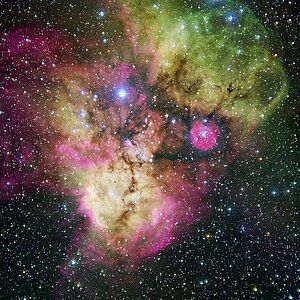NGC 2467
| Emission nebula | |
|---|---|
| NGC 2467
|
|

|
|
| Taken with the 2.2-m telescope of ESO at La Silla Observatory | |
| AladinLite | |
| Constellation | Aft deck of the ship |
|
Position equinox : J2000.0 , epoch : J2000.0 |
|
| Right ascension | 07 h 52 m 23.4 s |
| declination | -26 ° 26 ′ 36 ″ |
| Appearance
|
|
| Apparent brightness (visual) | 7.1 likes |
| Angular expansion | 15.0 ' |
| Ionizing source | |
| Physical data
|
|
| Affiliation | Milky Way |
| distance | 4400 ly (1355 pc ) |
|
history
|
|
| discovery | William Herschel |
| Date of discovery | December 9, 1784 |
| Catalog names | |
| NGC 2467 • OCL 668 • ESO 493-SC25 • LBN 1065 • Cr 164 • H IV 22 • GC 1589 | |
NGC 2467 is a still young open star cluster in the southern constellation Puppis (aft). It has an angular extent of 15.0 ′ and an apparent magnitude of 7.1 mag. The star cluster is about 4,500 light years from the solar system.
The star cluster is still in a cocoon of gas and dust in which its stars were formed . These massive stars are so hot that they mainly emit ultraviolet and short-wave blue light. The high-energy radiation excites the surrounding hydrogen to glow, with the reddish H-alpha radiation, which can be seen in the picture above. For this reason, such gas clouds are also called H-alpha or emission nebulae .
The object was discovered by William Herschel on December 9, 1784 .

Detail, Hubble Space Telescope
Web links
- The Cosmic Christmas Ghost. eso0544 - Picture released December 25, 2005
- Young stars in NGC 2467. Spektrum.de , July 14, 2010
- Image of the day. astronews.com, April 19, 2013
- Image of the day. astronews.com, August 20, 2013
- A ghost in the southern sky. eso1834 - Picture released, October 17, 2018